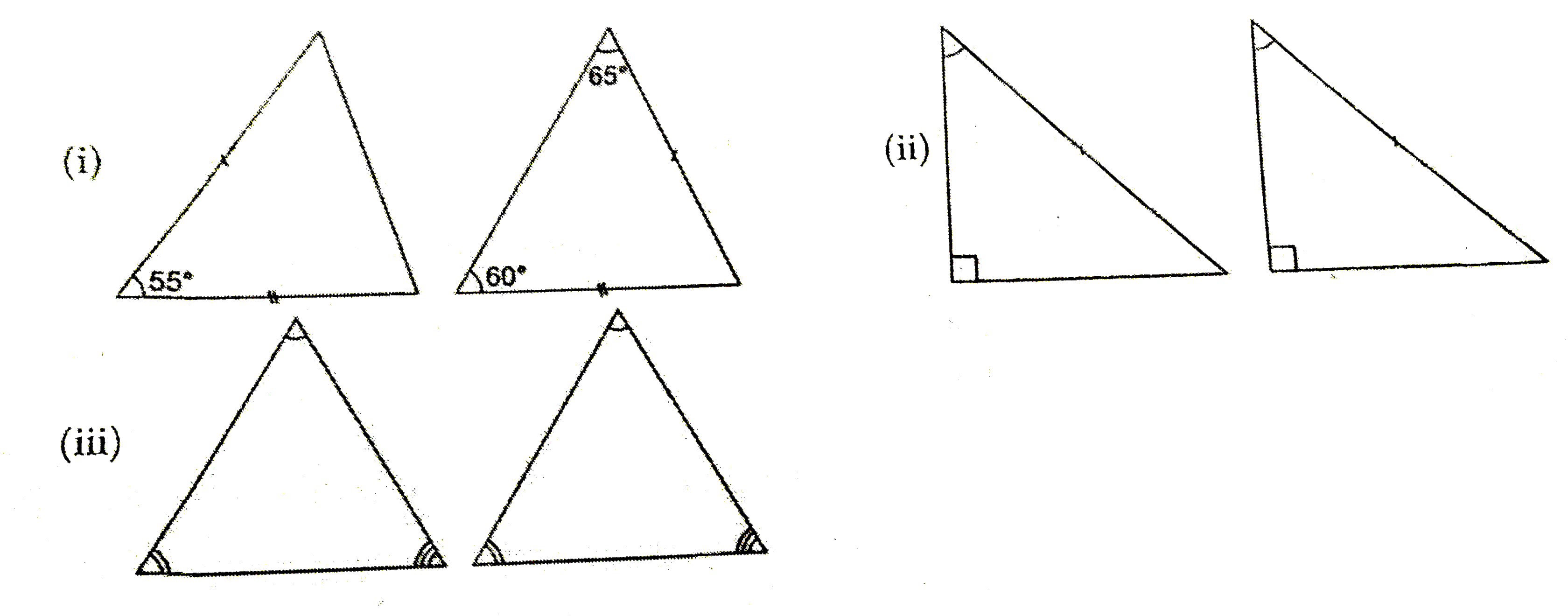If in ΔABCandΔDEF , ABDE=BCFD, then they will be similar, when
∠B=∠E
∠A=∠D
∠B=∠D
∠A=∠F
The correct Answer is:C
To determine when triangles ABC and DEF are similar given that the ratios of two pairs of corresponding sides are equal, we can follow these steps:
1. Understand the Given Information:
We are given that ABDE=BCFD. This indicates that two pairs of corresponding sides of triangles ABC and DEF are proportional.
2. Identify the Criteria for Similarity:
There are three main criteria for the similarity of triangles:
- AA (Angle-Angle): If two angles of one triangle are equal to two angles of another triangle, the triangles are similar.
- SSS (Side-Side-Side): If the corresponding sides of two triangles are in proportion, the triangles are similar.
- SAS (Side-Angle-Side): If two sides of one triangle are in proportion to two sides of another triangle and the included angles are equal, the triangles are similar.
3. Apply the Given Ratio:
Since we know that ABDE=BCFD, we can use the SAS criterion for similarity. However, we need to ensure that the angles between these sides are equal.
4. Check for Angle Equality:
We need to check if the angle between the sides AB and BC (which is angle B) is equal to the angle between the sides DE and FD (which is angle D). If ∠B=∠D, then we can conclude that the triangles are similar.
5. Conclusion:
Therefore, triangles ABC and DEF will be similar if ∠B=∠D in addition to the given proportionality of the sides. This can be stated as:
If ABDE=BCFD and ∠B=∠D, then △ABC∼△DEF (by SAS criterion).
Final Answer:
Triangles ABC and DEF will be similar if ∠B=∠D.
---
We are given that ABDE=BCFD. This indicates that two pairs of corresponding sides of triangles ABC and DEF are proportional.
There are three main criteria for the similarity of triangles:
- AA (Angle-Angle): If two angles of one triangle are equal to two angles of another triangle, the triangles are similar.
- SSS (Side-Side-Side): If the corresponding sides of two triangles are in proportion, the triangles are similar.
- SAS (Side-Angle-Side): If two sides of one triangle are in proportion to two sides of another triangle and the included angles are equal, the triangles are similar.
Since we know that ABDE=BCFD, we can use the SAS criterion for similarity. However, we need to ensure that the angles between these sides are equal.
We need to check if the angle between the sides AB and BC (which is angle B) is equal to the angle between the sides DE and FD (which is angle D). If ∠B=∠D, then we can conclude that the triangles are similar.
Therefore, triangles ABC and DEF will be similar if ∠B=∠D in addition to the given proportionality of the sides. This can be stated as:
If ABDE=BCFD and ∠B=∠D, then △ABC∼△DEF (by SAS criterion).
Triangles ABC and DEF will be similar if ∠B=∠D.
Topper's Solved these Questions
- TRIANGLESBook:NCERT EXEMPLAR ENGLISHChapter:TRIANGLESExercise:Very Short Answer Typw Questions
Explore 12 Videos
- TRIANGLESBook:NCERT EXEMPLAR ENGLISHChapter:TRIANGLESExercise:Short Answer Type Questions
Explore 15 Videos
- SURFACE AREAS AND VOLUMESBook:NCERT EXEMPLAR ENGLISHChapter:SURFACE AREAS AND VOLUMESExercise:LONG ANSWER TYPE QUESTIONS
Explore 20 Videos
Similar Questions
If in two ΔABC and ΔPQR, ABQR=BCPR=CAPQ, then
View SolutionIn ΔABCandΔDEF, ∠B=∠E,∠F=∠C and AB=3DE. Then, the two triangles are
View SolutionIf ΔABC~ΔDEF, AB=4cm, DE=6, EF=9 cm and FD=12 cm, then find the perimeter of ΔABC.
View SolutionWhich of the following pairs of triangles are congruent ? Also state the condition of congruency in each case :

(iv) In ΔABC and ΔDEF,AB=EF,BC=DF and ∠B=∠F
(v) In ΔABC and ΔPQR,AB=QR,AC=PR and ∠B=∠R
(vi) In ΔABC and ΔPQR,∠A=∠P,AC=PR and AB=PQ
(vi) In ΔABC and ΔPQR,AB=QR,∠A=∠Q and AC=QP.
View SolutionIf in a ΔABC,AD,BEandCF are the altitudes and R is the circumradius, then the radius of the circumcircle of ΔDEF is
View SolutionIn the given figure, ABC is a triangle. DE is parallel to BC and ADDB=32

Prove that ΔDEF is similar to ΔCBF.Hence, find EFFB.
View SolutionIf ΔABC~ΔEDF and ΔABC is npot similar to ΔDEF, then which of the following is not true?
View SolutionIn the ΔABC,AB=a,AC=candBC=b, then
View SolutionGiven : AB // DE and BC // EF. Prove that:

ADDG=CFFG
View SolutionIn the given figure, ΔABC is similar to ΔDEF,AB=(x−0.5) cm, AC=1.5xcm,DE=9cm,andDF=3xcm. Find the lengths of AB and DF.

View Solution